For a long time, Persians used to cook a variety of delicious dishes with sort of complicated ingredients. This fact indicates that Iranians cared a lot about the quality of their food throughout the history. Despite many eating cultures in other countries, Iranians use many ingredients and additives to their dishes. Follow us in the next paragraphs to check which 10 foods you should try when you are in Iran. Please also note that though these foods are available in many restaurants in Iran, you can experience their real taste if you try them at a Persian home, cooked by a Persian mom!
Kebab
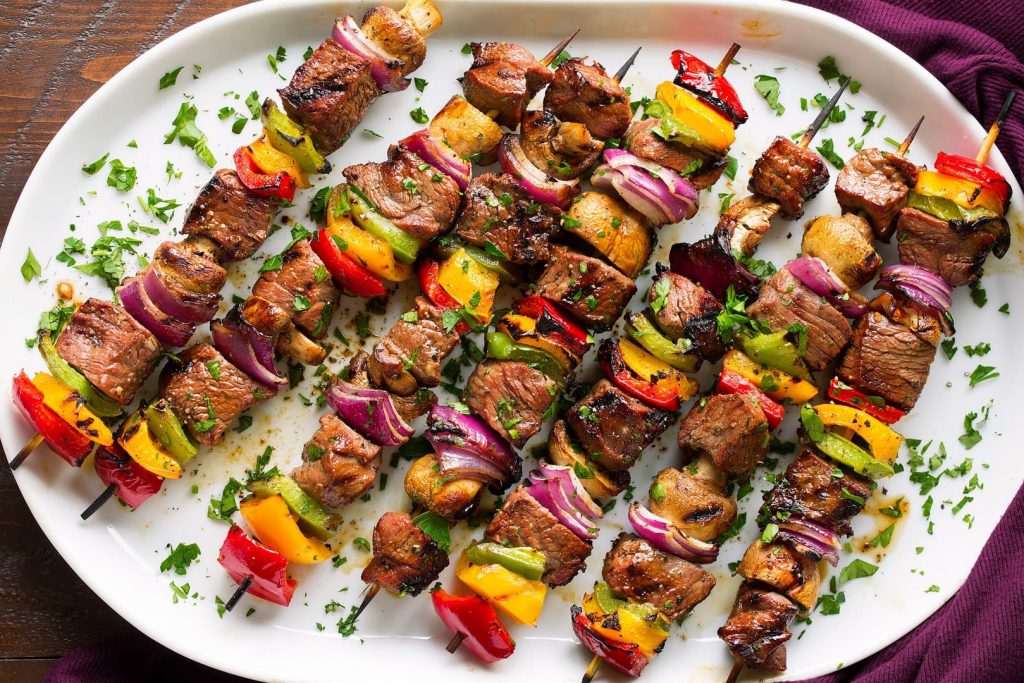
You must have heard the name of this heavenly delicious food as it is a very well-known food worldwide. It is a Middle-Eastern dish and no matter what kind it is, its taste and smell are unforgettable. Almost all kinds of meat including cut up meat, ground meat, chicken, or even seafood can be cooked on a skewer. The animal meat that you choose for this food is totally up to you. There are various recipes for cooking kebab but the main one is to cook on a skewer over the fire. This dish can be served with bread or rice.
Meat and chicken Kebab in Iran is always followed by a healthy drink called Doogh. It is a cold yogurt-based beverage with mint and salt. Moreover, Kebab is often eaten with fresh vegetables and yogurt.
Tip: do not try this dish if you are a vegetarian. Because if you do, you can never go on being a vegetarian again!
Ghormeh Sabzi

Ghormeh Sabzi is the most famous Persian stew and of course the most delicious one! You can find no Iranians who does not fall for such a dish!
Ghormeh Sabzi is a blackish green stew that is beautified with red dots in it that are actually the red beans. The green color shows the presence of freshly fried vegetables. The kind of vegetables and how much they are fried are of extreme importance in this dish. There is actually a joke in Iran that says you can find no two similar dishes of Ghormeh Sabzi due to the difference in the methods they are cooked. In addition to its vegetable, other ingredients are meat, red beans, dried lime, saffron, and salt. Like other stews in Iran, it is served with a bowl of aromatic Persian rice and saffron.
Things you can have with your meal are fresh vegetables, raw onion, Torshi (fruit or vegetable in vinegar), olive, and Persian Doogh as a drink.
Koofteh Tabrizi
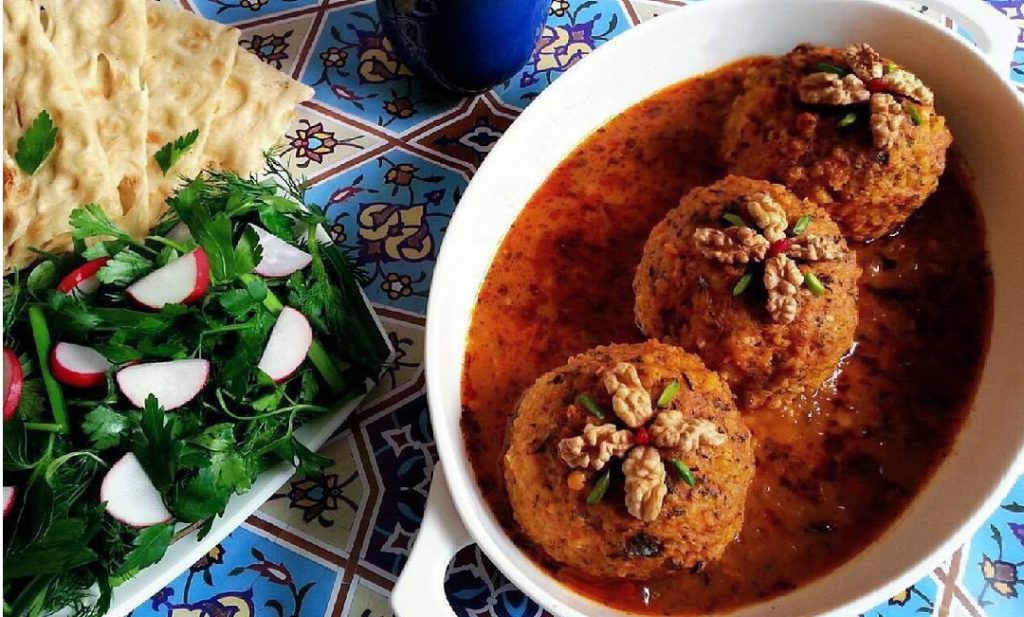
Koofteh Tabrizi is a traditional Iranian food originally cooked and served in Tabriz but is also cooked in other cities if there are any Tabrizi chef. Koofteh Tabrizi is a gigantic meatball that is eaten with traditional Sangak bread. It is soft and moist and its taste is way too awesome!
Its main ingredients are ground beef, onion, cooked split peas, which are all processed by a meat grinder. Some particular Iranian herbs and flavors are also added. The meatball is then stuffed with some fillings like dried nuts and peeled hardboiled eggs. Then it is put in a special sauce to be cooked slowly. The sauce consists of fried onions, tomato sauce, water, pepper, and salt.
Traditionally, people first cut the bread into small pieces in a large bowl and add the cooked sauce to it. This mixture is called Tilit which tastes great! Later, they eat Koofteh with bread, and some side dishes like fresh vegetables or Torshi, which is fruit or vegetable kept in vinegar for a while.
Fesenjan
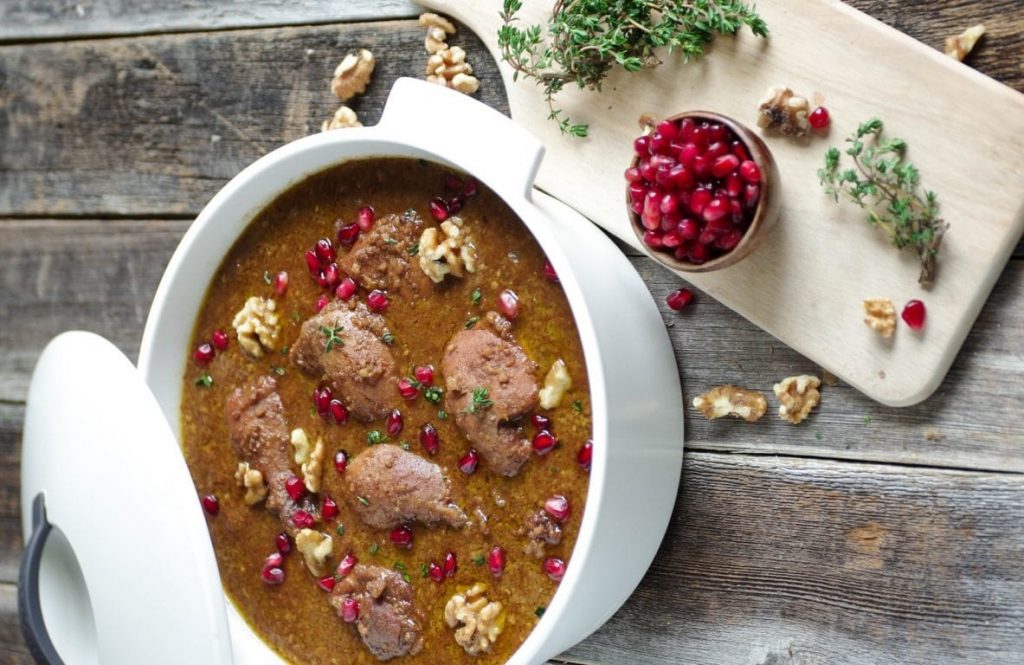
Khoresh_e Fesenjan or Fesenjan is an Iranian stew (=Khoresh) with a magnificent sweet-sour taste. It is one of the most favorite foods in Iran and the one that is often served in family parties or weddings.
Fesenjan is cooked with ground walnut and meatballs or chicken or sometimes duck or turkey. It is also traditionally flavored with pomegranate syrup which is really important for its particular taste.
The taste can be sweet, sour, or sweet-sour according to the tastes. However, the majority of Iranians prefer it to be sweet-sour. The stew is then served with rice. They tend to add saffron to the rice to make its taste even more splendid!
Baghali Polo
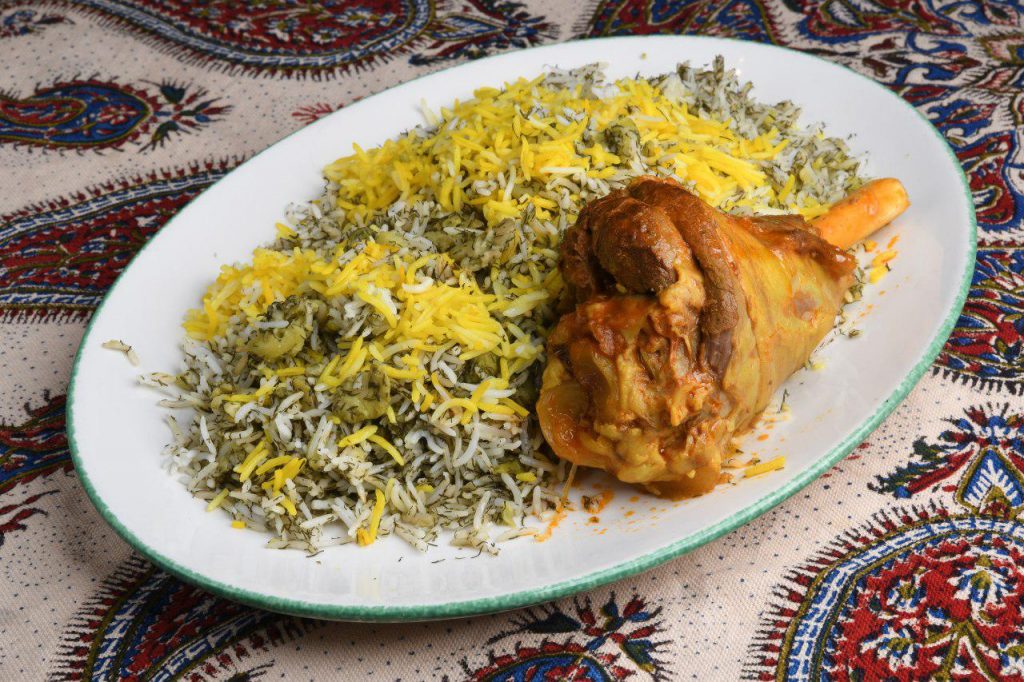
Another popular dish among Iranian families that are served in their parties and weddings is Baghali Polo that is rice with broad beans and dill served with braised lamb shanks or chicken.
Yes, broad beans only appear in spring in Iran but that is such a funny reason not to eat this delicious food in other seasons! Iranians buy a huge lot of broad beans in spring and freeze it as a source for the rest of the year. That is how this critical problem is solved! Its fantastic fragrance and above this world taste is proof that Persian cuisine is really professional and has been cared for since long ago.
Serve Baghali Polo with fresh herbs or salad. But remember to exclude Doogh with this dish as it will lead to an upset stomach.
Ab Goosht
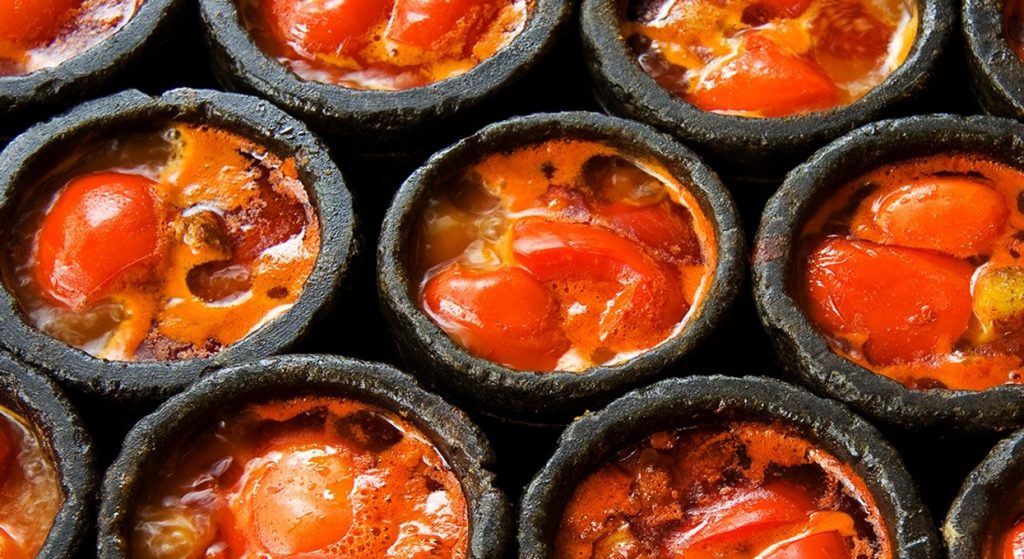
Weekend lunch in Iran is often accompanied with the warming smell of traditional stew Ab-Goosht (from Farsi – “water and meat” or “meat juice”). Thick, filling sauce is made of fresh lamb meat, potatoes, chickpeas, white beans, onions, tomatoes, dried lime, and spices like turmeric, pepper, and salt. The dish is usually served in a clay or stone pot called “dizi” – which also can be a name for the whole dish. In spite of seeming simplicity, Ab-Goosht offers rich taste and mouthwatering smell.
The eating process includes some important stages. First, the juice and the solid part of the dish are separated. Then, small pieces of bread are added to the juice until soften. It is called Tilit and is a sign that this dish is traditional. Iranians care a lot about what they eat and how they eat it. That is why they spend quite a long time with their families and devour a dish within several stages. After it is eaten, the solid part is mashed with an especially designed tool and eaten by bread, mostly by Sangak bread which is a traditional and healthy one. Iranians eat Ab-Goosht with bread, fresh herbs, and yogurt – this way each ingredient’s taste plays perfectly.
Ab-Goosht is a warming and comforting dish for family lunch with your loved ones.
Zereshk Polo
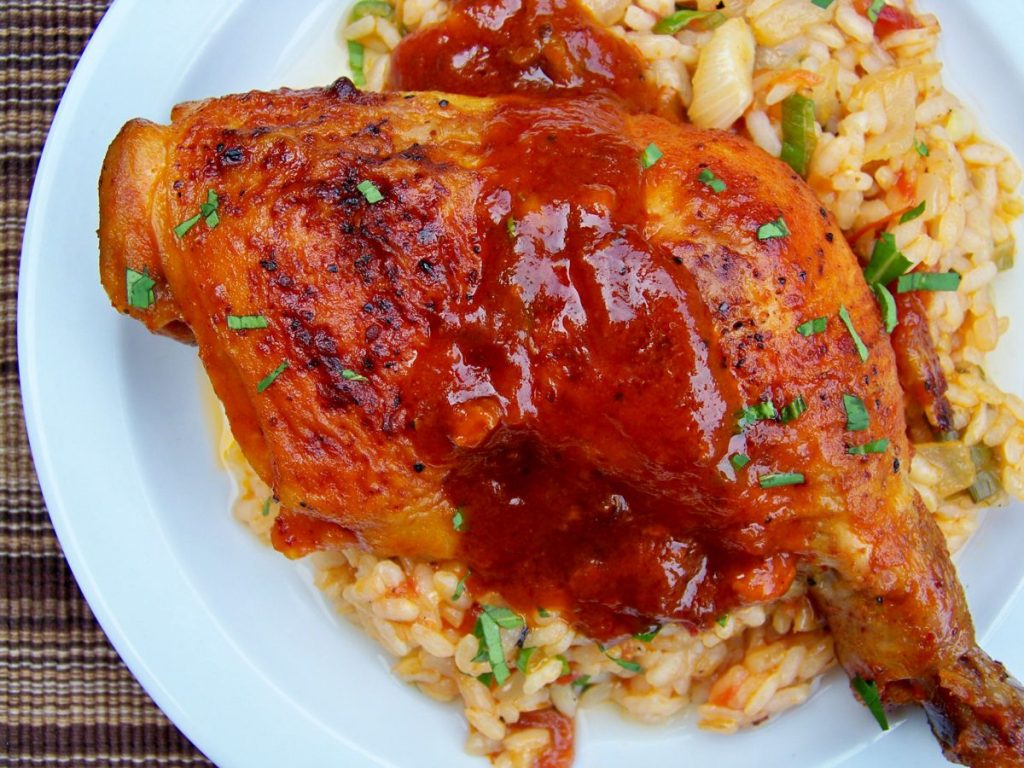
One of the most popular dishes in Iran is called Zereshk Polo which is served with chicken. The chicken is first boiled and cooked with garlic and onion to remove its unpleasant smell. Then, saffron, tomato sauce, pepper, and salt are added to it. Rice, on the other hand, is boiled and drained and is given time to be cooked. Then you serve it on a dish decorated with saffron and barberry. Do not miss this awesome dish! Try it once and you will always remember its great taste.
Tah Chin

It is an Iranian rice cake which is mostly made of rice, yogurt, egg, saffron, barberry, and a kind of meat mostly chicken. Additionally, there are different types of Tah Chin depending on the main ingredient used in the middle of two layers of rice, yogurt, and egg. They use lamb, eggplant, fish, meatball, or even stew in different types. Note that the fresher the ingredients are, the more delicious it would be.
Beryani
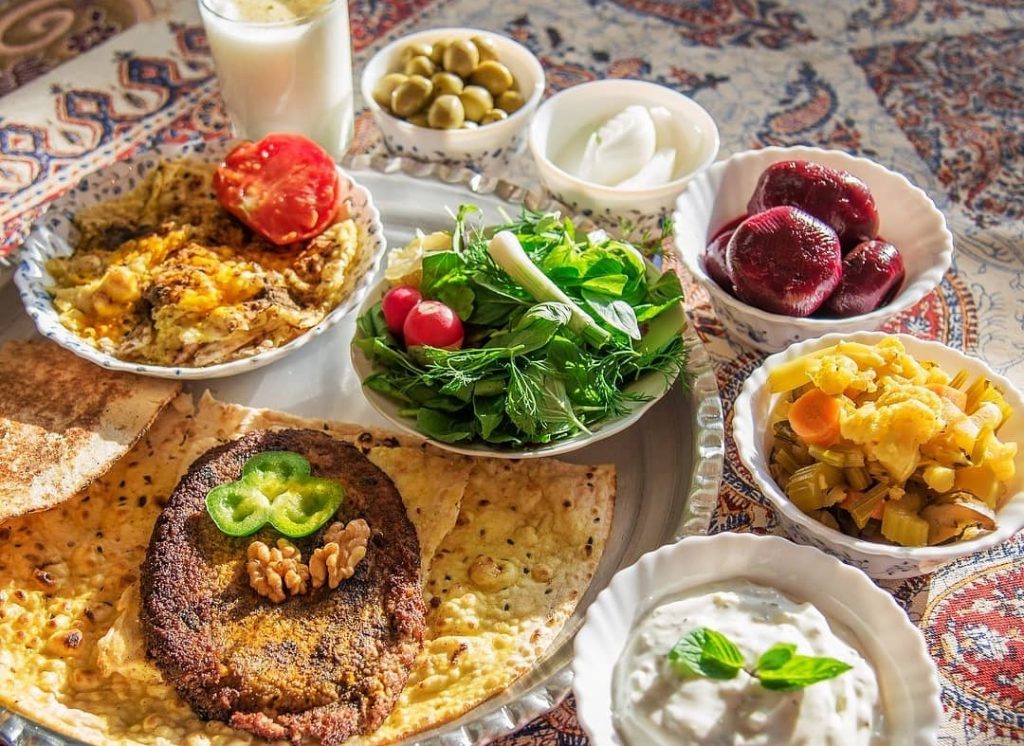
There are a thousand ways to cook meat in the world, and still, Iranians are successful in surprising travelers with interesting dishes. If you are planning to visit Isfahan and want to experience Isfahan local cuisine, you can try Beryani. In Farsi language, “beryani” means “fried”, but the process of cooking Beryani is more complicated than it sounds. The dish is made of lamb meat and fat with the addition of sheep's lungs. Meat is boiled with onion, then minced and mixed with fat and spices. The mixture is formed like a burger and fried on both sides. It is served with broth-softened bread, boiled and minced lungs, nuts, cinnamon, and greenery. Since the dish is filling and rich in fat, Iranians eat it with Doogh –which freshens you up and helps to digest the meal. Afterward, have a walk along Zayenderud River to enjoy the relaxed pace of the city.
Haleem

One of the most delicious Persian breakfasts is called Haleem. It is originated from Middle-Eastern countries and India. The structure and ingredients vary from country to country. However, the one that is eaten in Iran has meat and wheat in its ingredients. It has a very complicated cooking process and only a few people are able to cook it. It is mostly bought from restaurants in Iran and is usually eaten with traditional bread. Don’t forget to add butter, sugar, and cinnamon to make it even more delicious. You really have to try it!
Visit Iran and try these delicious dishes in a real traditional atmosphere to feel the true sense of being a Persian.
Tour FAQ
For one-day tours in Iran fully prepayment is required. For multi-day tours with the cost over 800 EUR, you have an option for partial prepayment and paying the rest upon your check-in.
If you don’t have access to your credit card or there is an issue with the online payment, please contact our support team via [email protected].
Depending on a tour, you can book one day in advance and earlier. Multiday tours in Iran require more preparation, so these ones should be booked in advance.
On the page of a tour on Apochi.com, you will see all available dates. Please take into consideration our cancellation policy while booking.
For one-day tours in Iran, our cancellation policy allows you to cancel your booking and get the full refund in case of cancellation more than 6 days in advance. If you want to cancel your tour booking in 1-5 days in advance, 50% will be refunded. Cancellation less than 24 hours in advance is non-refundable.
For multiday/multicity tours we have different cancellation policies. Please check cancellation policy for each individual tour.
You can choose the time for some half-day tours or private tours in Iran. For some group activities, events or full day tours the time can not be changed.
While booking for the most of the tours you can add round-trip transfer service to your order and we will pick you up from any location in the city and bring you back after the tour is finished. If the place of your accommodation is not listed on our website, contact our support team via [email protected] to arrange your transfer services.
You can also use public transport or take a taxi, the address of starting point will be written in a confirmation email from Apochi.com. In this case please be at the starting point at the time.
In case of using transfer services your guide will wait for you in the lobby of your hotel.
For multicity tours n Iran your guide will meet you upon your arrival at the Tehran airport (IKA airport).
For short sightseeing around cities of Iran, your guide will wait for you in front of the entrance/in a noticeable place in starting point. For all tours, we require your phone number and we will stay in touch via call or messengers. Let us know about your preferences via [email protected].
In case if we have any departure for the same day of your trip, we would be happy to connect people to a bigger group. Ask our support team about available opportunities during days of your stay via [email protected].
We support nature-friendly approach and accept both printed and digital voucher. You can save the confirmation letter on your phone or another mobile device to show to the guide.
Absolutely yes. Contact us via [email protected] to let us know if your plans have changed. Please mention that last minute changes may cause some fee.
For unforeseen situations, we do our best not to charge a fee. However, some charges are coming from our partner operators and are out of our control.
Sure. Please check timetable to be sure if you have enough time for joining the next tour.
We provide certified English speaking tour guides for public tours in Iran. If you need private tour, special services or language, contact us via [email protected].
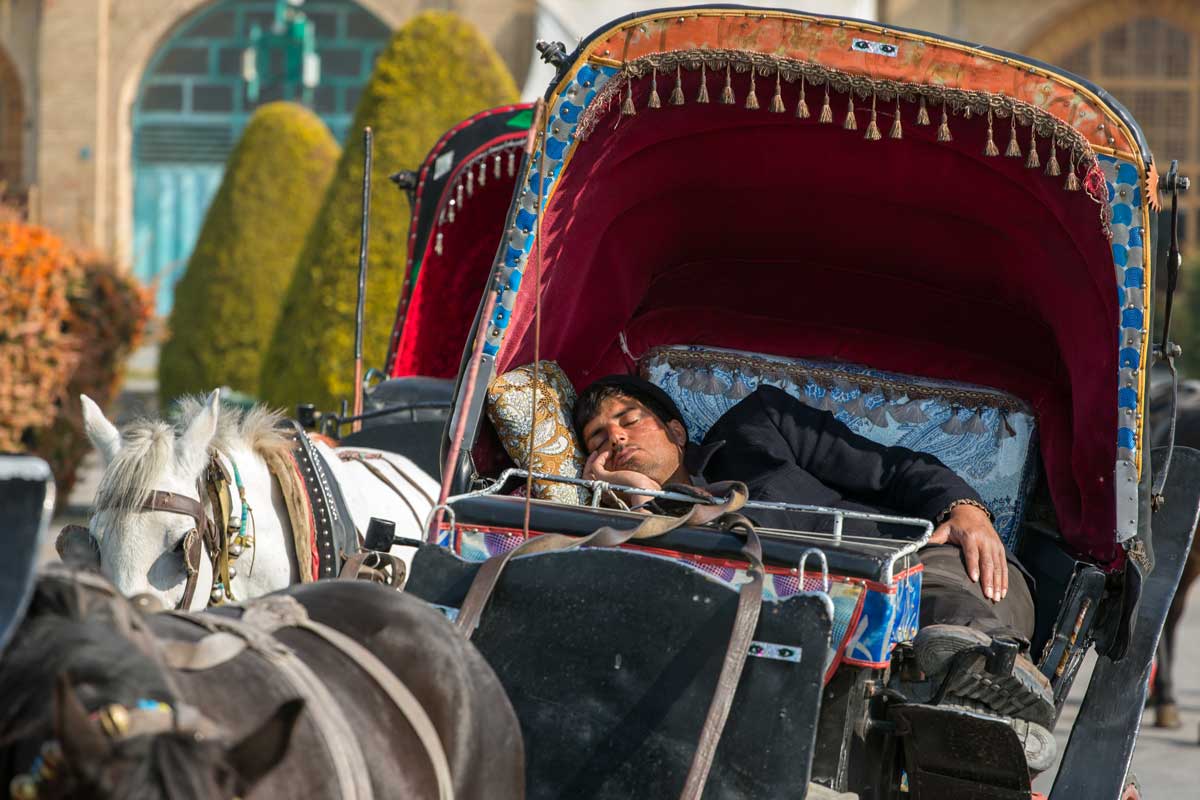
My Travel Experience in Iran – Kashan to Isfahan
Tehran to Tabriz Flights FAQ
There are about 22 flights from Tehran to Tabriz per week with a flexible schedule.
Tehran to Tabriz flights takes about 1 hour.
The prices for Tehran to Tabriz flights start from 29 €.
Late in spring and during summer is the best time to find cheap flights from Tehran to Tabriz. Therefore, you will find the cheapest flight deals to Tabriz during this time.
According to the laws, if you do not hold an identity document you won’t be allowed to take the flight just with your flight ticket. In case you do not hold any identity document you can use your driving license or credit card.
Mehrabad International Airport supports domestic flights and Imam Khomeini International Airport provides international flights. So to fly from Tehran to Tabriz you should go to Mehrabad Airport.
It depends on the airline that provides the flights from Tehran to Tabriz. Please check the main article or visit the Iranian Domestic Flight Baggage Allowance.
It is necessary to have your flight ticket printed or on your cell phone and valid identity document (driving license and passport) with you when boarding.
Different airlines have different policy. You can find the elaboration on that in the main article.
There are about 5 airlines that provide direct flights from Tehran to Tabriz. You can find their names and logos in the main text.
You can buy a plane ticket online for someone else whether you're buying the ticket for a family member, friend or even a business partner. Iranian airlines allow you to book a flight under a name that's different to the details of the person paying.






 Trusted
Partner
Trusted
Partner